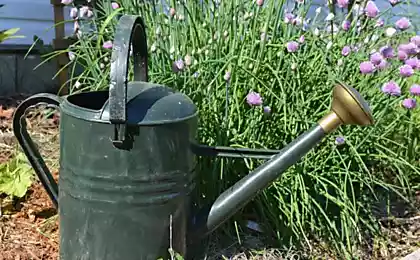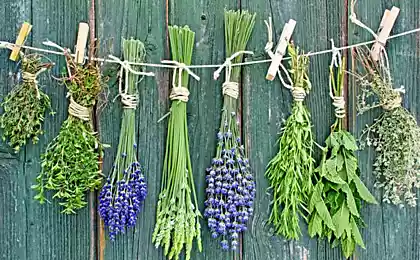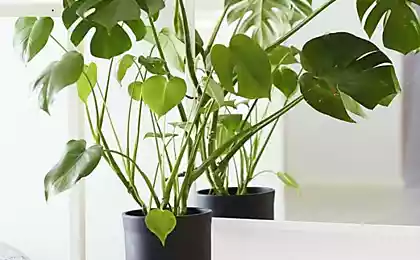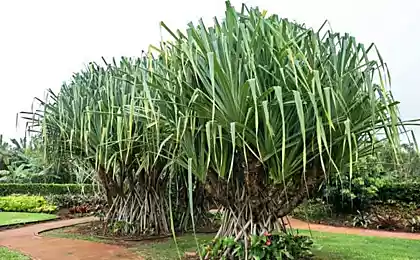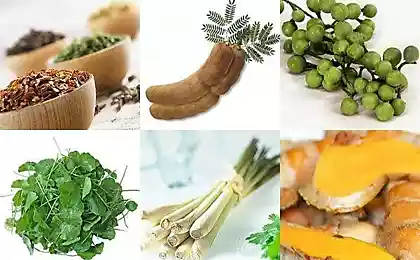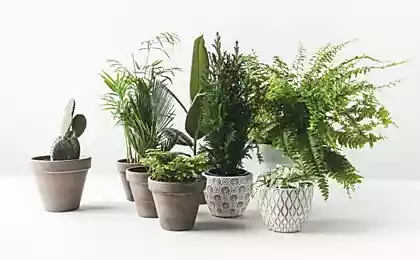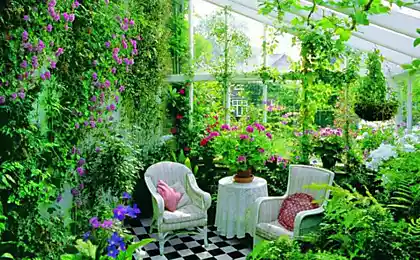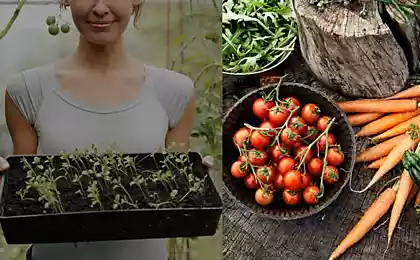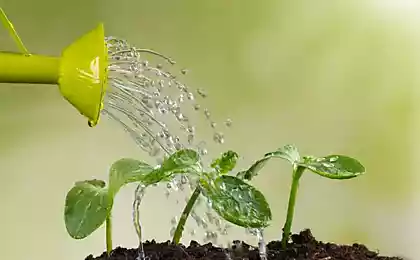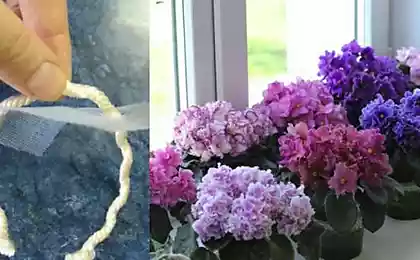618
Wick watering for houseplants
Recommendations for the care of houseplants is often found tip: watering should be moderate and regular. How to water the plants on time, especially if the collection exceeds 10-15 pots? We propose to use wick watering.
Wick watering method
Saintpaulia, gloxinia, ahimenes, episcia, chirita and other plants that need to grow in small pots, in loose substrate, it is necessary to water every other day. When the content of large collections, or when you want to go on vacation, it can become a serious problem. But to the rescue comes a wick method of irrigation, in which water and nutrient solution up to the roots of plants in synthetic cord.
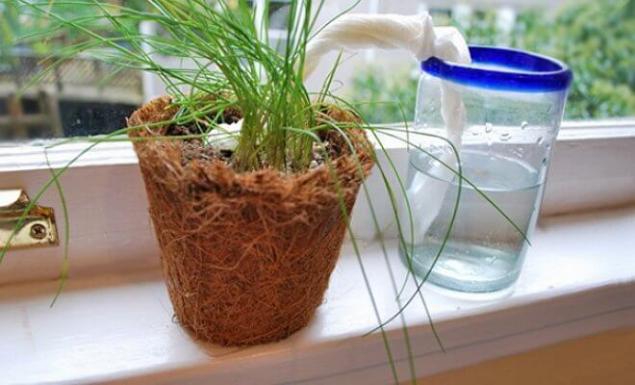
Pros
plants grow quickly and bloom
the watering time is reduced to 1 – 2 times a month depending on conditions
you can go without fear of death of plants
possible the drying of the roots
flowering in such plants are generally brighter and more luxuriant, and the flowers are larger.
Cons
in a humid environment at temperatures below +18°C there is a risk of root rot and the occurrence of fungal infections
the life processes are faster, so the faster the aging occurs
plants grown in the wicks, get a large — to save space, alas, will not work.
The cultivation of the wick in the land of the mixture
The soil must be chosen in accordance with the requirements of a specific plant. For wick watering it 30-40% of the total amount should be more perlite to the substrate was loose. Fertilize plants on the wick can in the usual way, basting the top with a solution of fertilizer in small quantities. Be sure that fertilizer does not put in a container with water, or use a foliar feeding. If the leaves began to turn yellow and become discolored, the plant is best repotted in fresh soil.
The cultivation of plants on the wick landless mixture
One of the ways of cultivation in landless mixture. The composition of the soil for gesneriaceae — peat+perlite in 1:1 ratio. This mixture is very poor, so when wick watering plants grown in containers with a nutrient solution, using fertilizer as a Etisso, Pokon, Kemira Suite, and others.
An approximate formula for growing in nutrient solution (N:P:K) 5:5:5 + trace elements. Breeding should be in the proportion 1:1000. If this fertilizer Etisso Hydro, the recommended dose for nutrient solution – 3 ml per 1 l of water.
The cord for the manufacture of the wick
The cord should be of synthetic material in order to avoid rotting. Check that it is well spent water. To do this, take a small dry piece of string and dip the tip into the water — it has quickly become wet. On a pot with a diameter 9 cm right cord with a diameter of 1.5-2 mm. Try that it was quite long and reach to the bottom of the tank.
The first 2 weeks to check whether enough moistened soil ball lost out of the plant turgor, is not reduced if the water in the tank. If the ground is dry, pull the extra cord, if too wet, take a few days for the plant: the roots are not sufficiently developed or the cord is too thick.
Capacity for wick watering
Capacity needs to be plastic, as the pot in which you plant plants. Plastic is easy to clean and disinfect. Capacity can serve as a plastic Cup or container with a lid and hole in it. Transparent container is much more convenient — you can monitor the water level. As the total capacity you can use a plastic tray with a grid.
Sometimes on the walls of the cups are formed by green algae, they do no harm to the plant – you just need to wash the container.
Laying the cord in the pot
In some sources it is recommended to lay the cord on the bottom in a circle:
But the best way to pull the wick – diagonal:
The hole for the pull cord should be in the middle of the bottom of the pot, but the manufacturers of plastic pots to make holes around the edge, so the wetting of excavation will occur unevenly. Accordingly, the development of roots and plants will also be uneven.
If unevenly distribute the wick is wet, only one half of the earth coma. For example, the roots of streptocarpus are planted correctly, will dry up where it is not enters the moisture and half of the aerial parts may die.
General rules for wick watering
When planting never uplotnaet the ground — to-air for the roots plays the same great role as moisture. It is advisable not to use as a planting mix a lot of peat, otherwise it will be difficult to moisten.
As drainage it's best to use polyester batting – it holds moisture and air, chemically neutral. You can use the large perlite. So it does not spill, need to put mesh on the bottom of the pot.
So the plant can absorb enough water, constantly flowing through the wick, it should have well-developed roots. Approximately 2 weeks after the transplant, try to keep the plant in the greenhouse, and then another 1-2 weeks under normal conditions and regular watering, preferably by the pallet, not to compacted earth com. For the best development of the roots of the plants can be watered with a solution of zircon or acoela (for the user). And only the grown plants can be translated into wick watering.
To be sure, it does wick water, put in a container of water should be pre-watered plants.
When growing on wick watering accelerates the development of plants: they grow faster, bloom faster and faster aging. The soil has to be changed more often due to salt deposits on the edges of the pot. Some collectors bring plants on wicks before flowering, to verify the correctness of the varietal color, and then transferred the plants on a regular watering. When changing irrigation is recommended to transplant the plant into a new nutritious soil.
On the pots indicate the date of landing – it is easier to determine whether the plant change.
Even development
A properly planted plant on the wick can be easily removed from the pot, the root system is very tight twisting around the soil ball and roots live and white.
Very often the roots are so well developed that go down the wick in a container of water (nutrient solution). Nothing wrong with that. But if you are going to put the plant on a regular watering or replant the outer roots should be cut.
If the plant is on the wick lost turgor, and the earth com – wet, immediately remove it from the fuse and check the roots. If they're brown, then they die or rot. In this case, the plant will be able to save only perukarnya.
High humidity when growing Saintpaulia stimulates the growth of side shoots, laterals. This is good if the variety is rare, because during the reproduction of stepchildren color is passed in 95% of cases. This is especially important when breeding chimeras. However, if you prepare the plant for the exhibition, the shoots need to be removed. They do not contribute to bloom, appearing in the leaf axils instead of the peduncle, besides the lost symmetry of the socket.
Summer skin
If you need to leave Mature plants, you can translate them with regular watering to wick and hold the wick between them. This should be done 2-3 weeks prior to departure to see if there is enough moistened soil ball. It happens that different plants in the same pots need wicks of different diameters – the larger the outlet, the more it needs water. Flowering plants also absorb more moisture. published
P. S. And remember, only by changing their consumption — together we change the world! © Join us at Facebook , Vkontakte, Odnoklassniki
Source: vk.com/wall-15012481?own=1&w=wall-15012481_79144
Wick watering method
Saintpaulia, gloxinia, ahimenes, episcia, chirita and other plants that need to grow in small pots, in loose substrate, it is necessary to water every other day. When the content of large collections, or when you want to go on vacation, it can become a serious problem. But to the rescue comes a wick method of irrigation, in which water and nutrient solution up to the roots of plants in synthetic cord.

Pros
plants grow quickly and bloom
the watering time is reduced to 1 – 2 times a month depending on conditions
you can go without fear of death of plants
possible the drying of the roots
flowering in such plants are generally brighter and more luxuriant, and the flowers are larger.
Cons
in a humid environment at temperatures below +18°C there is a risk of root rot and the occurrence of fungal infections
the life processes are faster, so the faster the aging occurs
plants grown in the wicks, get a large — to save space, alas, will not work.
The cultivation of the wick in the land of the mixture
The soil must be chosen in accordance with the requirements of a specific plant. For wick watering it 30-40% of the total amount should be more perlite to the substrate was loose. Fertilize plants on the wick can in the usual way, basting the top with a solution of fertilizer in small quantities. Be sure that fertilizer does not put in a container with water, or use a foliar feeding. If the leaves began to turn yellow and become discolored, the plant is best repotted in fresh soil.
The cultivation of plants on the wick landless mixture
One of the ways of cultivation in landless mixture. The composition of the soil for gesneriaceae — peat+perlite in 1:1 ratio. This mixture is very poor, so when wick watering plants grown in containers with a nutrient solution, using fertilizer as a Etisso, Pokon, Kemira Suite, and others.
An approximate formula for growing in nutrient solution (N:P:K) 5:5:5 + trace elements. Breeding should be in the proportion 1:1000. If this fertilizer Etisso Hydro, the recommended dose for nutrient solution – 3 ml per 1 l of water.
The cord for the manufacture of the wick
The cord should be of synthetic material in order to avoid rotting. Check that it is well spent water. To do this, take a small dry piece of string and dip the tip into the water — it has quickly become wet. On a pot with a diameter 9 cm right cord with a diameter of 1.5-2 mm. Try that it was quite long and reach to the bottom of the tank.
The first 2 weeks to check whether enough moistened soil ball lost out of the plant turgor, is not reduced if the water in the tank. If the ground is dry, pull the extra cord, if too wet, take a few days for the plant: the roots are not sufficiently developed or the cord is too thick.
Capacity for wick watering
Capacity needs to be plastic, as the pot in which you plant plants. Plastic is easy to clean and disinfect. Capacity can serve as a plastic Cup or container with a lid and hole in it. Transparent container is much more convenient — you can monitor the water level. As the total capacity you can use a plastic tray with a grid.
Sometimes on the walls of the cups are formed by green algae, they do no harm to the plant – you just need to wash the container.
Laying the cord in the pot
In some sources it is recommended to lay the cord on the bottom in a circle:
But the best way to pull the wick – diagonal:
The hole for the pull cord should be in the middle of the bottom of the pot, but the manufacturers of plastic pots to make holes around the edge, so the wetting of excavation will occur unevenly. Accordingly, the development of roots and plants will also be uneven.
If unevenly distribute the wick is wet, only one half of the earth coma. For example, the roots of streptocarpus are planted correctly, will dry up where it is not enters the moisture and half of the aerial parts may die.
General rules for wick watering
When planting never uplotnaet the ground — to-air for the roots plays the same great role as moisture. It is advisable not to use as a planting mix a lot of peat, otherwise it will be difficult to moisten.
As drainage it's best to use polyester batting – it holds moisture and air, chemically neutral. You can use the large perlite. So it does not spill, need to put mesh on the bottom of the pot.
So the plant can absorb enough water, constantly flowing through the wick, it should have well-developed roots. Approximately 2 weeks after the transplant, try to keep the plant in the greenhouse, and then another 1-2 weeks under normal conditions and regular watering, preferably by the pallet, not to compacted earth com. For the best development of the roots of the plants can be watered with a solution of zircon or acoela (for the user). And only the grown plants can be translated into wick watering.
To be sure, it does wick water, put in a container of water should be pre-watered plants.
When growing on wick watering accelerates the development of plants: they grow faster, bloom faster and faster aging. The soil has to be changed more often due to salt deposits on the edges of the pot. Some collectors bring plants on wicks before flowering, to verify the correctness of the varietal color, and then transferred the plants on a regular watering. When changing irrigation is recommended to transplant the plant into a new nutritious soil.
On the pots indicate the date of landing – it is easier to determine whether the plant change.
Even development
A properly planted plant on the wick can be easily removed from the pot, the root system is very tight twisting around the soil ball and roots live and white.
Very often the roots are so well developed that go down the wick in a container of water (nutrient solution). Nothing wrong with that. But if you are going to put the plant on a regular watering or replant the outer roots should be cut.
If the plant is on the wick lost turgor, and the earth com – wet, immediately remove it from the fuse and check the roots. If they're brown, then they die or rot. In this case, the plant will be able to save only perukarnya.
High humidity when growing Saintpaulia stimulates the growth of side shoots, laterals. This is good if the variety is rare, because during the reproduction of stepchildren color is passed in 95% of cases. This is especially important when breeding chimeras. However, if you prepare the plant for the exhibition, the shoots need to be removed. They do not contribute to bloom, appearing in the leaf axils instead of the peduncle, besides the lost symmetry of the socket.
Summer skin
If you need to leave Mature plants, you can translate them with regular watering to wick and hold the wick between them. This should be done 2-3 weeks prior to departure to see if there is enough moistened soil ball. It happens that different plants in the same pots need wicks of different diameters – the larger the outlet, the more it needs water. Flowering plants also absorb more moisture. published
P. S. And remember, only by changing their consumption — together we change the world! © Join us at Facebook , Vkontakte, Odnoklassniki
Source: vk.com/wall-15012481?own=1&w=wall-15012481_79144
Julia Roberts, Harrison Ford and other actors in the appeal on behalf of Nature to man
Japan will produce energy from space



